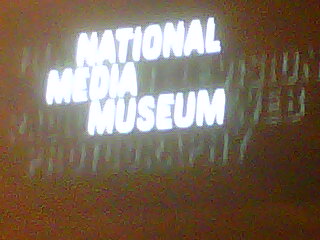
EXT. BRADFORD CITY CENTRE – NIGHT
The streets are ghostly quiet, and darkly illuminated. The lead character walks through Centenary Square, which itself has been mostly left dug-up. A bright big screen relays BBC News 24, but there is nobody else around to see or hear – other than him as he carries on along the soulless, darkly illuminated streets. There is a bouncer standing guard outside a plush bar with nobody inside.
It was a forbiddingly silent night in Bradford as I arrived at the Interchange tonight and took the short walk to the National Media Museum via the grand Gothic City Hall.
The last time I took the short train ride to the city, not even three weeks ago, I was told I’d treated it like the poor relation, making the familiar unfavourable comparison with Leeds at every opportunity.
But as I arrived this evening, if Bradford had been a film-set, it would have been the backdrop for the opening scene of an urban underworld film or some eerie post-apocalyptic thriller.
Whatever kind of picture it might have made, it would have been a far cry from anything of the sort that have come to life from the pen of Andrew Davies throughout his writing career.
Bradford’s showcase media museum welcomed Andrew this evening, in conversation with Neil Midgley, best known as one of The Telegraph’s top culture hacks.
The screenwriter behind famous adaptations from ‘House of Cards’ through to the Colin Firth ‘Pride and Prejudice’, and the recent BBC hit ‘South Riding’, I was invited this evening to hear him speak about his career and his work.
With these only the brightest shining diamonds on his record, Andrew is the man behind an array of great hits, and the odd rare miss (he made a foray into sitcom writing, with a show called ‘Game On’ which now occasionally airs at 2.20am on Dave, telling you all you need to know).
 Best-known for his period adaptations however, Davies’s works have achieved much critical acclaim, and more importantly in television than perhaps any other medium, widespread popularity.
Best-known for his period adaptations however, Davies’s works have achieved much critical acclaim, and more importantly in television than perhaps any other medium, widespread popularity.
For instance, his fifteen-part adaptation of Dickens’s ‘Bleak House’ broadcast in 2005 (yes, it makes me feel old too) benefited from a stellar and rather eclectic line-up (Gillian Anderson as Lady Dedlock, with cameos from Sheila Hancock and Ian Richardson, Alistair McGowan and Johnny Vegas), millions of pounds towards production, and prime billing on BBC1.
For Davies however, just as important was ultimately its familiarly modern-day style. Broadcast on the Beeb in a regular slot straight after ‘EastEnders’, it was an episodic serial much like the soap operas which still rule proud from the throne of British television, and importantly a drama in which every character somewhere becomes part of each others’ lives.
Listening to him mull over the mechanics of adapting works, familiar or not, was intriguing.
He described watching the famous climax of the first episode of the ‘House of Cards’ trilogy, itself adapted from the navel-gazing post-Thatcher novels by arch-Tory Michael Dobbs. As the pretty young journalist is thrown to her death by newly-instated old-school PM Urquhart (also her lover, whom she likes to call “Daddy”), having finally pieced together the puzzle of the blackmail, fraud, intimidation and murder that has lifted him to power, we see her dead body – eyes opened – falling down the roof of the van on top of which she’d landed.
Davies watched with a kind of morbid curiosity, and a self-consciousness too, appreciating slowly: “I did that… I killed her…”
 Adaptation, then, is far more creative for Davies than perhaps it might be for others. Also to his credit is the 2002 ‘Doctor Zhivago’, starring a young Keira Knightley. In the plush cinema at Bradford’s media museum where a good crowd received Andrew and Neil, we watched a clip of the earnest, impassioned young Yuri discussing humanity and love and such grand concepts in a town cafe. Out the window, he sees Keira’s Lara and is instantly mesmerised, before a creative flourish of camera trickery momentarily blends his reflection with her countenance.
Adaptation, then, is far more creative for Davies than perhaps it might be for others. Also to his credit is the 2002 ‘Doctor Zhivago’, starring a young Keira Knightley. In the plush cinema at Bradford’s media museum where a good crowd received Andrew and Neil, we watched a clip of the earnest, impassioned young Yuri discussing humanity and love and such grand concepts in a town cafe. Out the window, he sees Keira’s Lara and is instantly mesmerised, before a creative flourish of camera trickery momentarily blends his reflection with her countenance.
A beautiful moment, visually and thoughtfully; yet no part of the Pasternak novel. It was something Davies says that he wanted to include, having the two pass one another or unknowingly exchange a glance somewhere before their first “true” encounter.
Asked whether today he would be tempted to write his own original script (Davies still has many projects in the pipeline and is by no means short of work), he reflects and admits he probably would. But (tongue only slightly in cheek) he says he’d prefer to write his original work as a novel first, sell the rights for millions, and then write the screenplay himself. “I think that’s the opposite of a double-dip recession,” suggests Neil Midgley in the chair.
Adapting for the screen, big or small, is an interesting project wherever it’s attempted – and somehow it seems that whatever you do, someone will always take issue with it. If a novel is worth putting on film, then it must have readers who love it and who will regard as sacrilege (or just plain shoddy) any attempt to mould several hundred pages into a ninety-minute telecast.
I took almost the same short walk back to the train station (albeit darker, colder, even fewer cars on the roads) and thought of the rest of Bradford, outside the inspirational National Media Museum.
I’d read elsewhere about the Ways of Looking photography festival held this autumn at Bradford 1 Gallery – and in particular the exhibition of local family portraits taken by the Belle Vue Studios on Manningham Lane, many of which show immigrant families who had pictures made to send home to family abroad. Another chapter in Bradford’s story.
The hole in the ground at Forster Square and the dug-up earth near the beautiful City Hall seem to be attempts at creating a new Bradford story. Yet walking homeward, I thought of the old Bradford story that has long been written into the brickwork and the paving stones on every street.
The city already has a great story of its own; it simply needs a kind of fresh new adaptation to bring the viewers in and draw back the readers.
Fade to black.